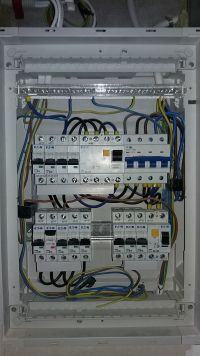Hello! The switchgear shown in the photo was made by an electrician. It is located in the attic of the house and supplies the apartment. And here's my question. Reading the forum, I found a few comments about the N wire, which, according to experienced forum users, should go directly to the N rail. For me, the electrician connected this wire first to the 4-pole FRa SD60 100A, with FRa it goes to the RCD and then to the N rail. stay that way, or should I change it e.g. using 3-pole Fra. I have a TN-S 3 phase system. The division of the PEN conductor was made in the main switchboard (connector) at the house. The power from the power plant to my premises is 14 kW. The same electrician installed the main 25A fuse upstream of the meter and a 3-pole SD60 100A fuse downstream the meter in the main switchboard (connector). The second problem is that for now I'm finishing the attic all the time and when I go home I turn off the power with a 16A circuit breaker. After 6 months, the main 3-phase switch, 25A at the bottom, in the main switchgear (connector) tripped. Does anyone know what it could have caused? My guess is that the miniature circuit breaker is not for everyday switching on and off and something rubbed and shorted  However, thanks to this incident, the question arises what to do to avoid going outside to the main switchboard in the event of a short circuit. I note that the RCD 40A did not work at all then. I greet everyone and wait for an answer.
However, thanks to this incident, the question arises what to do to avoid going outside to the main switchboard in the event of a short circuit. I note that the RCD 40A did not work at all then. I greet everyone and wait for an answer. 



